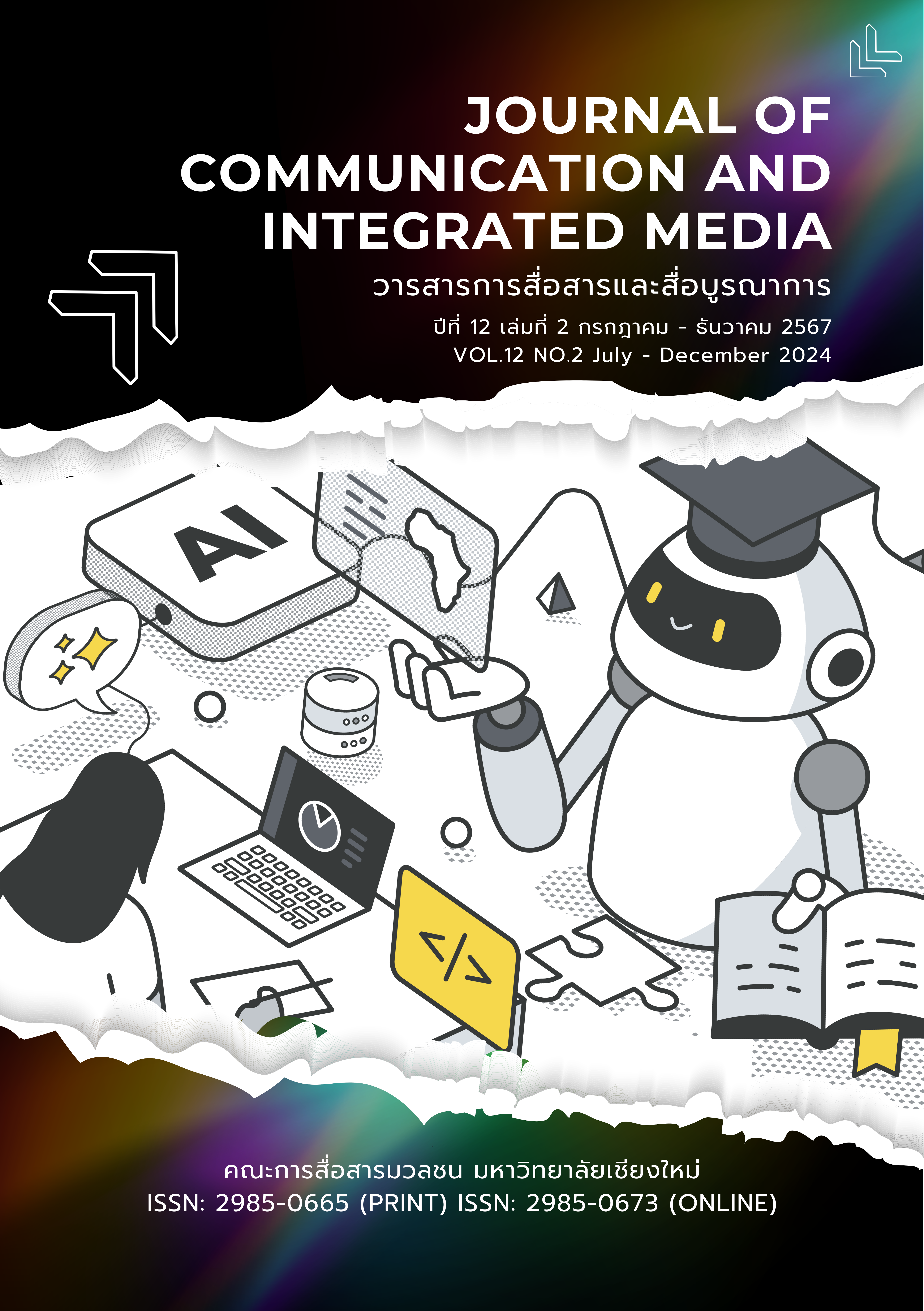แนวทางการปรับตัวและพัฒนาทักษะที่จำเป็นสำหรับนักครีเอทีฟในสร้างผลงานในการตลาดดิจิทัล
Main Article Content
บทคัดย่อ
การศึกษานี้มีวัตถุประสงค์ เพื่อศึกษาผลกระทบของการตลาดดิจิทัลที่มีต่อกระบวนการทำงานและเนื้อหาของผลงานครีเอทีฟ วิเคราะห์ความท้าทายที่นักครีเอทีฟต้องเผชิญในการตลาดดิจิทัล และเสนอแนวทางการปรับตัวและพัฒนาทักษะที่จำเป็นสำหรับนักครีเอทีฟในการตลาดดิจิทัล เป็นการวิจัยเชิงคุณภาพด้วยวิธีการสัมภาษณ์เชิงลึกกับแบบสัมภาษณ์กึ่งโครงสร้าง โดยกลุ่มผู้ให้ข้อมูลหลัก จำนวน 12 คน ได้แก่ นักครีเอทีฟในอุตสาหกรรมโฆษณา จำนวน 6 คน นักการตลาดและนักวิชาการทางด้านการตลาด จำนวน 6 คน ที่เคยผลิตผลงานโฆษณาในช่วง พ.ศ. 2562-2566 อย่างน้อย 3 เรื่อง การวิเคราะห์ข้อมูล ใช้การสร้างข้อสรุปเป็นกรอบแนวคิดแบบอุปนัย เพื่อศึกษาปรากฏการณ์พิสูจน์และวิเคราะห์สังเคราะห์เป็นข้อสรุปในการตีความ ผลการศึกษาพบว่า การเติบโตอย่างรวดเร็วของสื่อดิจิทัลและแพลตฟอร์มสื่อสังคมออนไลน์ส่งผลกระทบต่อกระบวนการทำงานและเนื้อหาของผลงานครีเอทีฟในการตลาดดิจิทัลมากที่สุด ความท้าทายที่นักครีเอทีฟต้องเผชิญในการตลาดดิจิทัลมากที่สุด คือ การปรับมุมมองและเรียนรู้ซึ่งกันและกันระหว่างนักการตลาดและนักครีเอทีฟเพื่อรักษาอัตลักษณ์ และมาตรฐานในการสร้างสรรค์ผลงานสร้างสรรค์ ในที่สุดได้แนวทางการปรับตัวและพัฒนาทักษะที่จำเป็นสำหรับนักครีเอทีฟในการตลาดดิจิทัลที่สำคัญ คือ การปรับมุมมองและเรียนรู้ซึ่งกันและกันของนักการตลาดและนักครีเอทีฟลดความขัดแย้งและก่อให้เกิดการทำงานร่วมกันที่ราบรื่น
Article Details

อนุญาตภายใต้เงื่อนไข Creative Commons Attribution-NonCommercial-NoDerivatives 4.0 International License.
ลิขสิทธ์ที่ผู้เขียนบทความต้องยอมรับ
เอกสารอ้างอิง
โยทกา บุญชู. (2564). กระบวนการทำงานของฝ่ายคิดและสร้างสรรค์โฆษณาบนสื่อสังคมออนไลน์ในบริษัทตัวแทนโฆษณาด้านดิจิทัล ผ่านกรณีศึกษา บริษัท สปอร์ บางกอก จำกัด (Spore Bangkok) [สารนิพนธ์ปริญญาวารสารศาสตรบัณฑิต]. มหาวิทยาลัยธรรมศาสตร์.
สมาคมสื่อช่อสะอาด. (2564, 14 กุมภาพันธ์). วิกฤติอุตสาหกรรมสื่อ-โฆษณาฝ่าวงล้อมโควิด.https://www.chorsaard.or.th/content/39699/วิกฤติอุตสาหกรรมสื่อ-โฆษณา-ฝ่าวงล้อมโควิด
สาวิตรี รินวงษ์. (2563, 26 เมษายน). วิกฤติอุตฯ สื่อ-โฆษณาฝ่าวงล้อมโควิด. กรุงเทพธุรกิจ.https://www.bangkokbiznews.com/business/877880.
เสรี วงษ์มณฑา. (2547). ครบเครื่องเรื่องการสื่อสารการตลาด. บริษัทธรรมสาร.
อริสรา โหงวบุญล้อม. (2566). รูปแบบปัจจัยที่เอื้อต่อการเปลี่ยนผ่านองค์กรสู่ดิจิทัล [วิทยานิพนธ์ปริญญามหาบัณฑิต]. มหาวิทยาลัยมหิดล.
Aaker, D. (2016, January 4). The four faces of digital marketing. Americanmarketing association. https://www.ama.org/marketing-news/the-four-faces-of-digital-marketing/
Beeftink, F., Van Eerde, W., Rutte, C. G., & Bertrand, J. W. M. (2012). Being successful in a creative profession: The role of innovativecognitive style, self-regulation, and self-efficacy. Journal ofbusiness and psychology, 27, 71-81.
Boczkowski, P. J. (2004). Digitizing the news: Innovation in online newspapers. MIT Press. https://doi.org/10.7551/mitpress/2435.001.0001
Bozkurt, A. E., & Tan, S. (2021). Concepts of creativity in design based learning in STEM education. International Journal of Technology and Design Education, 31(3), 503-529.
Burnett, R. & Marshall P. D., (2003). Web theory: An introduction. Routledge.
Caves, R. E. (2000). Creative industries: Contracts between art and commerce. Harvard University Press.
Chiou, S. C., Lin, H. K., & Huang, C. H. (2020). The challenges of creative collaboration in the digital age: A case study of a Taiwanese advertising agency. Creativity and Innovation Management, 29(4), 683-695.
Crews, K. D. (2020). Copyright law for librarians and educators: Creative strategies and practical solutions. American Library Association.
Deuze, M. (2007). The web and its journalisms: Considering the consequences of different types of news media online. New Media & Society, 5(2), 203 - 230.
Gao, Q., Wu, C., Wang, L., & Zhao, X. (2020). The entrepreneur’s psychological capital, creative innovation behavior, and enterprise performance. Frontiers in Psychology, 11, 1651. https://doi.org/10.3389/fpsyg.2020.01651
Gulati, R., & Reaiche, C. H. (2020). Soft skills: A key driver for digital transformation. In Proceedings of the ICDS, 14, 40-43.
Hackley, C. & Kover, A. J. (2007). The trouble with creatives: Negotiating creative identity in advertising agencies. International Journal of Advertising, 26(1), 63-78.
Hall, F. R. C. (2020). Creative digital collaboration in publishing: How do digital collaborative partnerships work and how might publishing companies adapt to facilitate them?. UCL (University College London).
Hearn, G. (2020). The future of creative work creativity and digital disruption. Edward Elgar Publishing. https://doi.org/10.4337/9781839101106
Hollebeek, L. D., Sprott, D. E., & Brady, M. K. (2021). Rise of the machines? Customer engagement in automated service interactions. Journal of Service Research, 24(1), 3-8.
Hussain, B., Latif, A., Timmons, S., Nkhoma, K., & Nellums, L. B. (2022). Overcoming COVID-19 vaccine hesitancy among ethnic minorities: A systematic review of UK studies. Vaccine, 40(25), 3413-3432.
Kelly, S. (2019). Thailand 2019 Salary Guide. Kelly
Kraus, S., Jones, P., Kailer, N., Weinmann, A., Chaparro-Banegas, N., & Roig-Tierno, N. (2021). Digital transformation: An overview of the current state of the art of research. Sage Open, 11(3), https://doi.org/10.1177/21582440211047576
Lövfors, W., Ekström, J., Jönsson, C., Strålfors, P., Cedersund, G., & Nyman, E. (2020). A multi-level model analysis of lipolysis and fatty acid release from adipocytes in vitro and from adipose tissue in vivo. bioRxiv. PLOS ONE. https://doi.org/10.1101/2020.12.18.423229
Malmelin, N., & Nivari Lindström, L. (2017). Rethinking creativity in journalism: Implicit theories of creativity in the Finnish magazine industry. Journalism, 18(3), 334-349. https://doi.org/10.1177/1464884915620272
Marra, J. L. (1990). Advertising creativity: Technique for generating ideas. Prentice-Hall.
McStay, A. (2011). The mood of information: A critique of online behavioural advertising. A&C Black.
Mele, C., Russo-Spena, T., Tregua, M., & Amitrano, C. C. (2021). The millennial customer journey: A phygital mapping of emotional, behavioural, and social experiences. Journal of Consumer Marketing, 38(4), 420-433.
Mkhize, S., & Ellis, D. (2020). Creativity in marketing communication to overcome barriers to organic produce purchases: The case of a developing nation. Journal of Cleaner Production, 242, https://doi.org/10.1016/j.jclepro.2019.118415
Partanen, J., & Waldén, H. (2021). Team academy and entrepreneurship education. Routledge.
Patrickson, B. (2021). What do blockchain technologies imply for digital creative industries?. Creativity and Innovation Management, 30(3), 585-595.
Pratt, A. C., (2021). Creative hubs: A critical evaluation. City, Culture and Society, 24. https://doi.org/10.1016/j.ccs.2021.100384
Sasser, S. L., & Koslow, S. (2008). Desperately seeking advertising creativity: Engaging an imaginative" 3Ps" research agenda. Journal of Advertising, 37(4), 5-20.
Tripathy, M. (2020). Relevance of soft skills in career success. MIER Journal of Educational Studies Trends and Practices, 91-102.
Van Laar, E., Van Deursen, A. J., Van Dijk, J. A., & De Haan, J. (2020). Determinants of 21st-century skills and 21st-century digital skills for workers: A systematic literature review. Sage Open, 10(1), 1-14. https://doi.org/10.1177/2158244019900176


